Introducción
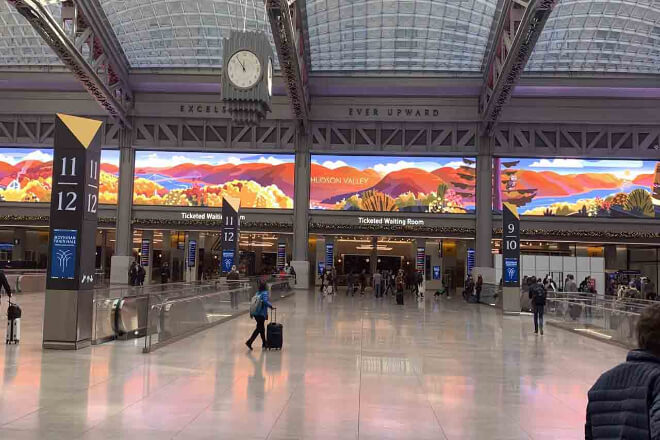
In high-traffic areas like transportation hubs, information delivery is crucial.
Imagine thousands of people travelling through aeropuertos, train stations, and subway stations every day. How can everyone easily access the latest information they need?
This is where Pantalla LED systems become “superheroes.” They not only display real-time traffic information but also provide clear directions in busy environments.
Next, let’s discuss how to design an efficient and flexible LED information display system tailored to the characteristics of transportation hubs, ensuring smoother information dissemination and more convenient travel.
Tabla de contenido
1. Why Choose an LED Display System for Transportation Hub Information Display Solutions?
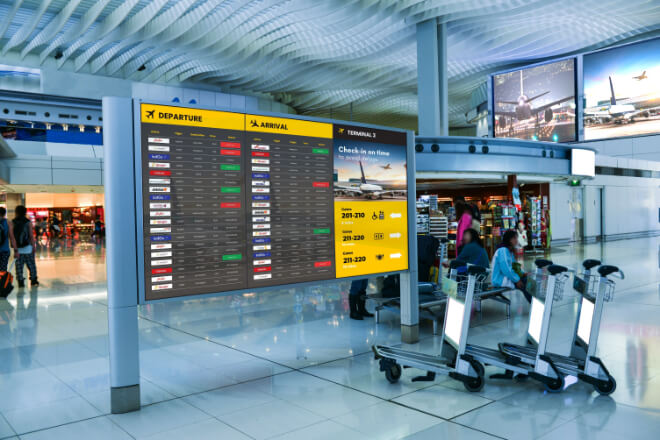
We’re talking about places with high traffic volumes, where thousands of people may need to see clear and accurate information every second.
Pantalla LED de paso pequeño systems, with their various superpowers, have become the “superheroes” of transportation hub information displays.
Let’s discuss why LED displays have become the “heart” of these places!
1) High Brillo and All-Weather Visibility
Imagine yourself standing in a crowded train station, facing glaring sunlight or dim nighttime lights. At this moment, can you clearly see the information on the display?
This is precisely the strength of LED displays! Their ultra-high brightness ensures clear reading, whether under scorching sun or dimly lit at night.
Whether you’re a commuter rushing to work or a traveller lugging luggage, the brightness of LED displays allows you to grasp every crucial piece of information without losing sight.
2) Flexibility and Dynamics
The information needs of transportation hubs are as ever-changing as the weather. Today’s train schedules, today’s train schedules, today’s emergency announcements—you can never predict them.
The real-time updating function of LED displays is a true godsend! Want to see the time of a train, flight, or emergency announcement? Switch instantly!
These screens not only display the latest train schedules and directions, but can also issue announcements based on emergencies.
Flexibility is their hallmark; any information can be arranged at any time!
3) Versatility
Beyond traditional information displays, LED displays are versatile! They can display train schedules, directions, and even emergency announcements.
While also providing space for businesses to display advertisements. LED screens in busy stations can also generate extra revenue for advertising.
For example, while waiting for your train, you can browse new fashion releases, travel deals, and even food recommendations for your next destination.
Watching the ads and completing your shopping list at the same time—who wouldn’t love this convenience?
4) Energy Saving and Environmental Protection
Imagine a transportation hub operating day and night. If the display screens consumed a lot of power, what a headache! Fortunately, LED screens are both energy-efficient and environmentally friendly.
They are much more efficient than traditional display systems, saving significant electricity costs.
In large, high-frequency areas like airports and train stations, the low-energy design of LED screens is suitable for long-term operation without the risk of power crises. Simply put, it saves money and worry!
5) Easy Maintenance
LED display systems in transportation hubs often operate over a long period of time, and minor issues are inevitable. But don’t worry! The modular design of LED screens makes repairs incredibly easy.
If a small part breaks, simply replace that part without having to replace the entire screen. This not only reduces downtime but also makes maintenance simpler and faster, eliminating the need for major projects.
Operator staff can also breathe a sigh of relief—replacement and maintenance are no longer a burden.
2. How to Design an LED Information Display System Based on the Characteristics of a Transportation Hub?
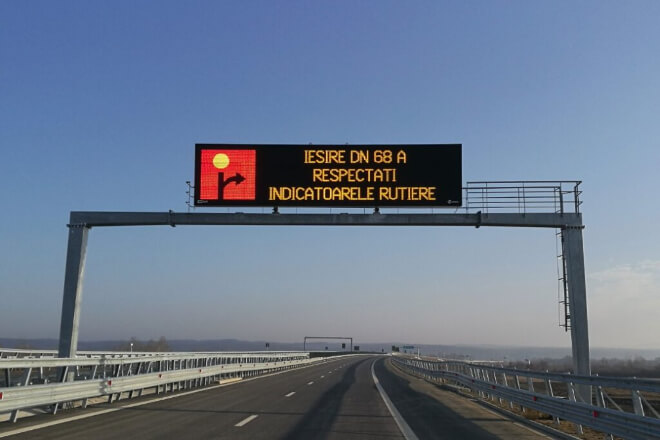
1) Spatial Layout Analysis
Different areas of a transportation hub have different needs, so the design can’t be the same for all.
Waiting areas and high-traffic areas should feature large, eye-catching LED screens, ensuring visibility from every corner.
Departure halls, on the other hand, may need to display flight or train information, which requires a large amount of information and greater precision.
You can’t clutter a single large screen with train schedules, advertisements, and weather forecasts; that wastes screen space and creates a dizzying effect.
Displays in passageways and entrances can be smaller, displaying only essential route directions or brief announcements.
Different areas require different design solutions to maximise the screen’s effectiveness.
2) Information Hierarchy and Display Format
Transportation hubs can be overwhelmed by the sheer volume of information, but the content displayed on the screens must not be a chaotic mess!
You need to present information in layers, with the most important information, such as train schedules and directions, taking centre stage in large fonts and bright colours.
Other secondary information, such as advertisements and weather, can be placed in a smaller, more subdued font and colour palette.
Imagine this: when passengers arrive at a station, the large overhead screen should display key reminders like “Stand Firm, Your Train is Approaching,” while advertisements and other content can be displayed on other screens to avoid overwhelming passengers.
3) Content Display and Interface Design
In busy transportation hubs, people don’t have time to decipher complex interfaces, so simplicity and intuitiveness are paramount.
Information displayed should be easily understood at a glance—use large fonts and harmonious colour combinations.
For example, red could be used to remind passengers to “hurry up,” while green could indicate “smooth progress.”
For fonts, choose simple, unadorned fonts to ensure that most passengers can easily read them from a distance.
Avoid artistic fonts that appear to be aesthetically pleasing but offer little else. Simple is beautiful!
4) Screen Resolución and Size
The screen’s resolution and size are closely related to how close you stand to it. If you’re farther away, a higher resolution is recommended for clear viewing.
If you’re closer, a lower screen resolution can actually reduce unnecessary resource waste.
When choosing a screen size, try to base it on viewing distance. For large waiting areas, a larger screen is recommended; for aisles, a smaller screen can be used, but it must provide a clear view.
In short, choose the right size based on different distancias de visualización y ángulos de visión to ensure clear information while avoiding waste.
5) Interactive Features
Sometimes, people don’t just want to see flight or train information; they may also want to check routes or ask questions.
This is where interactive touch screens come in handy!
In high-traffic areas, design several interactive screens so passengers can access information on their own.
For example, they can view detailed information about their train or find nearby restaurants, restrooms, and more.
This not only saves time waiting in line to ask staff, but also provides a better passenger experience.
However, remember to keep the user interface simple. Don’t fumble around trying to figure out how to use it when you’re rushing to catch a train.
3. Specific Applications of LED Information Display Systems at Different Transportation Hubs
At transportation hubs, the biggest fear is losing information or missing your train. LED display systems act as “navigators” in these busy environments, helping us quickly find our way around.
1) Subways and Train Stations
Subways and train stations are crowded places, overflowing with information.
LED displays display train schedules, real-time status updates, ticket information, and emergency announcements.
While waiting in line, you can easily see the next train’s time, eliminating the need for anxious waiting on the platform.
In the event of an emergency, LED displays can also remind passengers to “stay safe,” ensuring a smoother journey.
2) Aeropuertos
Airport LED displays are even more crucial, ensuring passengers never miss a single message.
They provide flight status, gate information, security checkpoints, and directions to the baggage claim area, helping you know immediately whether your flight is on time and which gate to go to.
At the baggage claim area, they also tell you which conveyor belt your luggage is waiting for you.
In short, LED displays are like “encyclopedias” in the airport, saving you from the frustration of getting lost.
3) Bus Stops and Bus Stations
LED displays at bus stops and bus stations are also incredibly useful.
They provide real-time updates on bus arrivals, fares, and routes, and even display weather forecasts, letting you know if you should bring an umbrella.
For example, on rainy days, you can check the arrival time of your bus on an LED display so you can plan ahead. With clear information, you no longer have to fight for a seat in a crowd!
4) Highways and Parking Lots
On highways and parking lots, LED displays help control traffic flow, provide exit directions, and display parking information.
If you know there might be traffic jams on the highway or construction ahead, LED screens will alert you in advance.
In parking lots, LED screens will indicate available spaces, saving you time and effort.
5) Integrated Transportation Hubs
In integrated transportation hubs, such as large train stations or transportation centres, LED screens serve as “information centres,” displaying arrival and departure information for multiple modes of transportation simultaneously, helping you quickly find your transfer route.
Displaying information for different trains, subways, buses, and more on the same screen not only saves space but also allows for more efficient transfers.
4. Key Technical Considerations in LED Information Display System Design
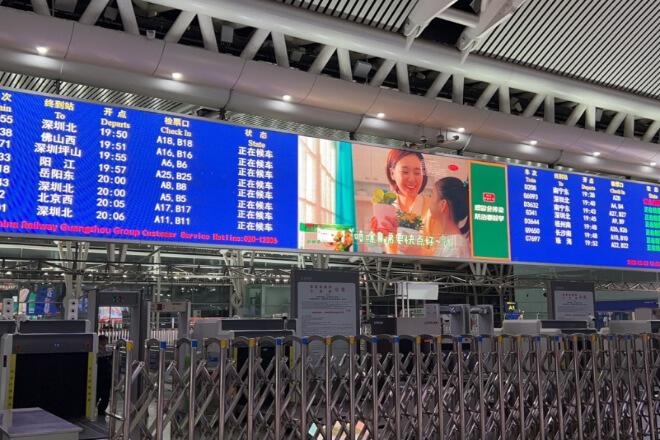
Imagine standing at a station waiting for a train under the scorching sun, your eyes blinded by the screen’s brillo.
Or, at night, the screen becomes as bright as a stage spotlight, blinding you.
To avoid this, adjusting the brightness and colour temperature of LED displays is crucial.
During the day, the screen’s brightness should be high enough to ensure that the content remains clearly visible even under strong sunlight.
At night, the colour temperature should be lowered, creating a softer light that is more comfortable for the eyes and avoids irritating “glare” light sources.
Thus, designers must ensure that screens can “breathe naturally” in varying lighting conditions, maintaining clarity and comfort.
In busy places like subway stations and airports, passengers demand up-to-date information at all times.
Imagine waiting to board your flight at the airport, and suddenly one screen displays “Flight Departed” while another displays “Flight Arriving Soon.”
That scene could be frustrating! In such situations, real-time information updates and system stability become crucial.
LED display systems must not only withstand massive data flows but also ensure that updates are delivered without delay, accurately and promptly to passengers, and avoid confusion caused by errors.
Displays in transportation hubs, especially those outdoors, are subject to the elements, including wind, rain, scorching sun, and sometimes even blizzards.
The LED displays here must be like “tough warriors,” requiring exceptional waterproofing, dustproofing, and shockproofing.
Imagine the embarrassment of a luxurious train station if its LED screens were damaged by rain, dust accumulation, or vibrations, causing the image to shift.
The screens must be designed to withstand environmental interference and maintain a clear display, ensuring stable operation and protection from damage, whether in torrential downpours or dusty deserts.
If you’re at an airport or train station, you might see multiple displays scattered across various locations: some in the waiting hall, others in the aisles, and still others at baggage claim.
So, how do you ensure consistent information across all screens? The answer is multi-screen interconnection and synchronised display.
Each screen should work seamlessly, and when information is updated, all should be updated simultaneously, ensuring passengers don’t see conflicting or confusing information in different areas.
For example, changes to train arrival times and boarding gates should be displayed simultaneously on all screens to avoid confusion among passengers.
We all know that environmental protection is crucial, and LED displays are a great help in saving energy.
By choosing energy-efficient LED technology and equipping it with an intelligent control system, energy consumption can be significantly reduced.
For example, the system can automatically adjust the screen brightness based on ambient light, dimming it when no one is around, thus reducing unnecessary energy waste.
This not only reduces electricity bills but also helps reduce carbon footprint and protect the environment.
In modern design, energy conservation and sustainability have become essential considerations, allowing LED displays to provide convenience while also contributing to environmental protection.
5. The Commercial and Operational Value of LED Display Systems for Transportation Hubs
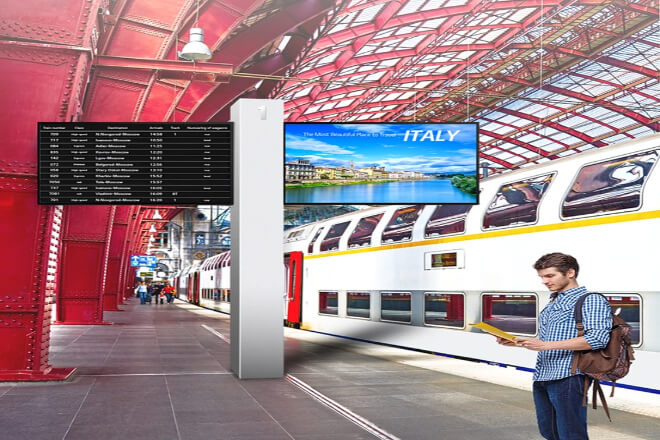
1) Improving Transportation Efficiency and Passenger Experience
Imagine you’re at a train station or subway station, luggage in hand, about to ask the staff which train is leaving, when you suddenly see a clear LED display telling you the exact arrival time of the next train.
No more anxiety or worry about missing your train. The real-time, accurate information provided by LED displays makes navigating busy transportation hubs much easier.
This reduces anxiety and allows passengers to find the right information more efficiently, improving overall travel efficiency.
This smoother experience in turn strengthens passengers’ trust and goodwill in the transportation hub.
2) Increasing Advertising Revenue
Beyond providing transportation information, LED displays can also generate additional revenue streams for transportation hubs.
You can display a variety of advertising content on these displays, from coupons for local stores to brand promotional videos to information about upcoming events.
This not only increases exposure for businesses but also generates stable advertising revenue for the transportation hub.
Especially in large, integrated transportation hubs, LED displays can reach a large number of passersby, significantly increasing the value of advertising.
Furthermore, as passengers wait longer, the advertising content on the screens also creates more opportunities for businesses to see their content.
3) Reduced Labour Costs and Error Rates
Traffic hub staff used to need to constantly update information by manually entering data such as schedules, routes, and ticketing, which inevitably led to errors.
Automated LED display systems significantly reduce manual intervention, improving work efficiency and significantly reducing the incidence of manual input errors.
Real-time information updates are automatically performed by the system, reducing both the chance of errors and labour costs.
While saving labour, the system also runs more smoothly and reliably, improving the operational efficiency of the entire hub.
4) Brand Image and Modern Perception
Digitalisation and intelligence have become an integral part of modern transportation hubs, and LED display systems perfectly align with this trend.
Through clear and modern information presentation, LED display systems can effectively enhance a transportation hub’s brand image and modern perception.
When passengers enter a transportation hub with a highly digital display, they are not only impressed by the service but also perceive the brand’s high-end and professional character.
More advanced facilities and more efficient services can significantly enhance a hub’s brand value in the eyes of passengers.
6. Examples of LED Information Display Systems in Global Transportation Hubs
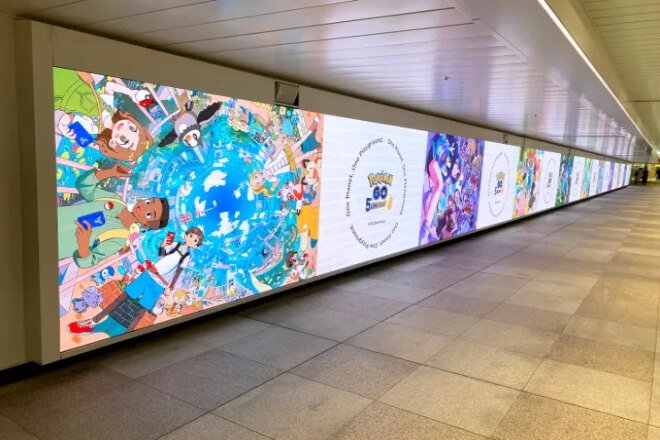
1) Tokyo Station
As one of Japan’s busiest transportation hubs, Tokyo Station sees passengers coming and going daily.
The station’s LED display system plays a vital role in enhancing the passenger experience.
Real-time train schedules, weather forecasts, and tourist information are all displayed on LED screens.
Whether waiting for a train or preparing for a transfer, passengers can easily access the latest train status and check the weather forecast to prepare.
In addition, LED screens provide tourist information, making it easier for foreign visitors to navigate an unfamiliar city.
2) Singapore Changi Airport
Singapore Changi Airport is one of the most modern airports in the world, and the use of LED displays has taken its service quality to a new level.
LED screens are ubiquitous throughout Changi Airport, displaying everything from flight information to signage and advertisements within the airport—all displayed on clear, eye-catching LED screens.
For example, upon entering the airport, passengers can access flight status, gate information.
And flight delays at any time via LED displays. Various advertisements also generate additional revenue for the airport.
LED displays not only facilitate smoother passenger flow but also enhance airport operations.
3) Shanghai Hongqiao Airport
As one of Shanghai’s major aviation hubs, Hongqiao Airport’s LED displays play an irreplaceable role in information display.
Flight information, security instructions, terminal information, and emergency notifications are all delivered to passengers in real time via LED displays.
Especially during flight changes, LED displays provide fast and clear updates, avoiding confusion caused by delays or gate changes.
Furthermore, in emergencies, LED displays can quickly issue emergency notifications, ensuring the safe and orderly flow of passengers.
This contributes to more efficient and organised operations throughout the airport.
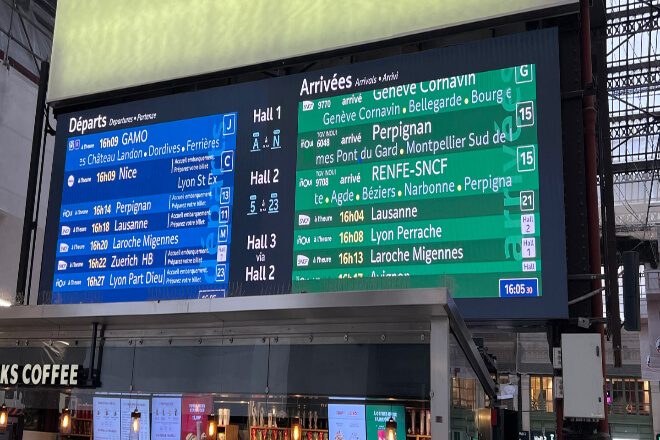
4) Paris Metro
The Paris Metro is one of the busiest metro systems in the world, and within this vast system, LED displays play a crucial role.
LED displays are installed at numerous metro stations, displaying key information such as passenger arrival times and train schedules.
Whether you’re rushing to the next train or waiting on the platform, LED displays provide real-time updates on arrival times, ensuring you never miss a moment.
These displays not only provide passengers with a clearer understanding of train arrival and departure times, but also provide information about the next train, significantly improving subway operation efficiency.
7. Conclusión
In short, LED display systems are not only the “information brain” of transportation hubs but also the key to improving overall operational efficiency.
From accurately displaying train information to efficiently managing advertising revenue and ensuring stable system operation, the use of LED displays can make every hub more intelligent and convenient.
Por último, para obtener más información sobre las pantallas LED, Por favor póngase en contacto con nosotros.
